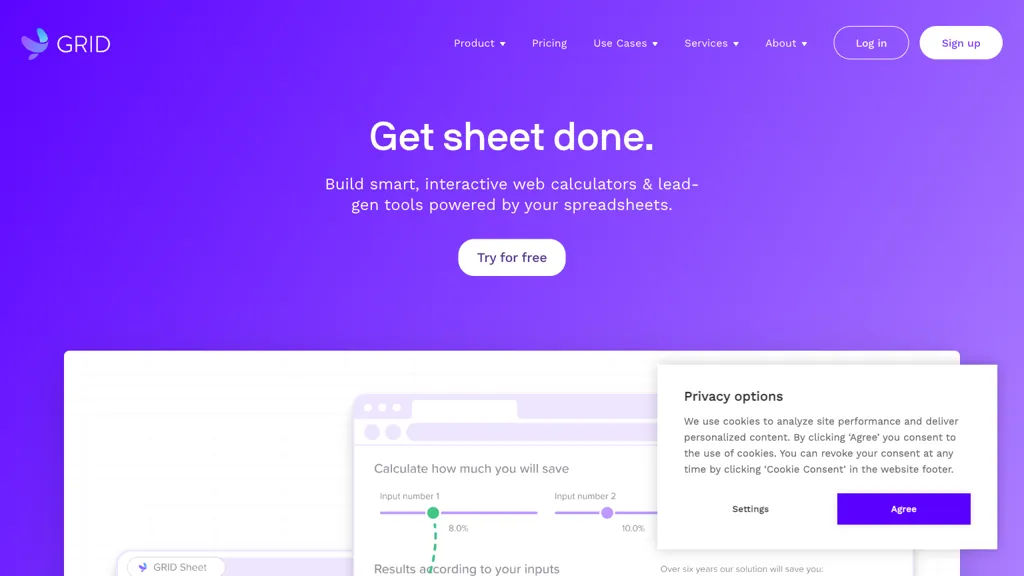What is GRID 2.0?
GRID 2.0 is the innovative platform that empowers users to create smart, engaging web calculators and lead generation tools with the power of spreadsheets. This allows any person or business to bridge over their lead generation and selling tools cohesively, creating a dynamic spreadsheet-driven calculator for lead capture without coding knowledge.
Using GRID 2.0, users can transform passive spreadsheets into interactive calculators and forms, empowering prospects to learn complex pricing models or, probably, know the money they can save. That’s a conversion that will provide much better user experience and force meaningful interaction with a potential client.
Key Features and Benefits of GRID 2.0
GRID 2.0 is equipped with features that place it at the very top of many different users’ lists:
- Build calculators of many types, from price quote calculators to ROI calculators and TCO calculators.
- Capture leads directly through the interactive calculators.
- Seamlessly integrate with CRM systems to get timely priority and manage leads.
- Supports a large variety of spreadsheet file types and cloud drives for easy access and usage.
- Offers customized project support in special or unique needs.
Embedding
Calculators can be embedded in websites directly to facilitate user participation. With GRID 2.0, one would be able to boost the conversion rate of websites while qualifying leads on the basis of calculator inputs—especially valuable in terms of delivering highly valuable insights to prospects. In addition, this would be very easy to do since the platform is versatile and user-friendly, which makes it essential when it comes to enhancing interactive content and lead generation strategies.
GRID 2.0 Use Cases and Applications:
GRID 2.0 can be used in a number of situations, hence making it a versatile tool for various industries in the following aspects:
- Conceptualization of lead-capture calculators that are interactive and with no coding.
- Empowering prospects to examine pricing models or calculate their potential savings.
- Improving website conversion rates by engaging prospects through dynamic content.
- Qualify leads based on inputs from the calculators in order to facilitate the sales process.
GRID 2.0 can be used in several industries: marketing, web development, business analytics, and customer relationship management. For example, it can help marketing professionals design more compelling pricing models while CRM customers leverage it for improved lead priority and management.
How to Use GRID 2.0
GRID 2.0 features a very user-friendly interface; thus, using it is pretty straightforward. Here is a step-by-step guide on how to do it:
- Upload your spreadsheet file or connect your cloud drive.
- Select the type of calculator or form that interests you to be created.
- Configure the calculator—define inputs and outputs according to your spreadsheet data.
- Share on your website or with a link; capture leads through this calculator.
- Monitor and analyze the leads captured through this calculator.
For best results, follow best practices, such as having clean spreadsheets, fully customizing the design to fit your brand, and testing calculators for errors before going live.
How GRID 2.0 Works
GRID 2.0 works by turning legacy spreadsheets into dynamic web-calculators. Advanced algorithms of the platform understand data and formulas in spreadsheets, driving computations in real-time and interactively. One can define inputs and outputs, which may be used in building compelling forms and calculators ready to be embedded on websites.
Workflows involve uploading a spreadsheet and setting up the calculator, then sharing it either embedded on a website or with a link. This smoothes out the process for users to generate potent interactive tools without writing code.
Pros and Cons of GRID 2.0
GRID 2.0 has its pros and some possible cons like any other tool. Its pros include:
Pros
- User-friendly interface with no coding required.
- It offers different kinds of calculators and custom options.
- Integrate with CRM systems and cloud drives seamlessly.
- Improve website conversion rates and lead qualification.
Cons
- It may be time-consuming to set up complex calculators.
- It’s limited by the capabilities of the spreadsheets that underlie it.
The user feedback mainly describes that this platform is user-friendly and offers excellent value for lead generation, but some users pointed out that the initial setup may take some time on the more complex projects.
Conclusion on GRID 2.0
Published, GRID 2.0 is one such powerhouse of a platform to build interactive in-web calculators and lead generation tools powered by spreadsheets. From the ease of use of its user interface and large feature set to the ability to integrate seamlessly with CRM systems, it will be of immense help to businesses moving their engagement and lead generation online.
It can only get even better in the future, given further developments and improvements set to make the platform more versatile and efficient. If you’re a business or professional seeking to harness the power of interactive content, GRID 2.0 is one to watch out for.
GRID 2.0 FAQs
What spreadsheet file types does GRID 2.0 support?
GRID 2.0 supports many spreadsheet types of files and cloud drives so that its users can easily access and use it.
Will I need coding skills to use GRID 2.0?
No, GRID 2.0 has been developed to be as user-friendly as possible and it doesn’t require any kind of coding.
Are the calculators created with GRID 2.0 customizable?
Yes, the calculators can be customized to suit specific needs or brand design.
How do I embed the calculator on my website?
After making a calculator, GRID 2.0 provides you with an embed code that you may attach to your website to make the calculator available to your visitors.
What are the benefits of the integration of GRID 2.0 with any CRM system?
Integration of GRID 2.0 with a CRM system enables proper lead management and lead prioritization for wiser sales.










